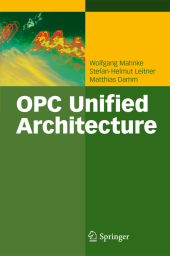 Neuerscheinungen 2010Stand: 2020-01-07 |
Schnellsuche
ISBN/Stichwort/Autor
|
Herderstraße 10
10625 Berlin
Tel.: 030 315 714 16
Fax 030 315 714 14
info@buchspektrum.de |

Matthias Damm, Stefan-Helmut Leitner, Wolfgang Mahnke
(Beteiligte)
OPC Unified Architecture
Softcover reprint of hardcover 1st ed. 2009. 2010. xxiii, 339 S. 177 SW-Abb., 94 Tabellen. 235 mm
Verlag/Jahr: SPRINGER, BERLIN 2010
ISBN: 3-642-08842-2 (3642088422)
Neue ISBN: 978-3-642-08842-1 (9783642088421)
Preis und Lieferzeit: Bitte klicken
The new OPC Unified Architecture unifies existing standards for online data exchange between automation systems. This introduction to OPC UA explains the concept of the standard and other relevant topics not directly addressed by the standard.
Motivation for This Book The OPC Foundation provides specifications for data exchange in industrial au- mation. There is a long history of COM/DCOM-based specifications, most pro- nent OPC Data Access (DA), OPC Alarms and Events (A&E), and OPC Historical Data Access (HDA), which are widely accepted in the industry and implemented by almost every system targeting industrial automation. Now the OPC Foundation has released a new generation of OPC specifications called OPC Unified Architecture (OPC UA). With OPC UA, the OPC Foundation fulfills a technology shift from the retiring COM/DCOM technology to a servi- oriented architecture providing data in a platform-independent manner via Web Services or its own optimized TCP-based protocol. OPC UA unifies the previous specifications into one single address space capable of dealing with current data, alarms and events and the history of current data as well as the event history. A remarkable enhancement of OPC UA is the Address Space Model by which v- dors can expose a rich and extensible information model using object-oriented techniques. OPC UA scales well from intelligent devices, controllers, DCS, and SCADA systems up to MES and ERP systems. It also scales well in its ability to provide information; on the lower end, a model similar to Classic OPC can be used, providing only base information, while at the upper end, highly sophisticated models can be described, providing a large amount of metadata including complex type hierarchies.
Information Modeling: Concepts.- Information Modeling: Example and Best Practice.- Standard Information Models.- Services.- Technology Mapping.- Security.- Application Architecture.- System Architecture.- Mapping of COM OPC to OPC UA.- Migration.- Profile.- Performance.- Conclusion and Outlook.- Literature.


